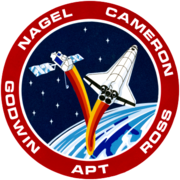STS-37
| STS-37 | |||||
 | |||||
| Uppdrag | 39 | ||||
|---|---|---|---|---|---|
| Rymdfärja | Atlantis (8)[1] | ||||
| NSSDC-ID | 1991-027A[2] | ||||
| Färdens tid | 5 dagar, 23 timmar, 32 minuter, 44 sekunder | ||||
| Uppskjutning | |||||
| Startplats | Startplatta 39B vid Kennedy Space Center i Florida | ||||
| Start | 5 april 1991, 9:22:44 a.m. EST | ||||
| Landning | |||||
| Landningsplats | Runway 22, Edwards AFB, Calif. | ||||
| Landning | 11 april 1991, 6:55:29 a.m. PDT | ||||
| Omloppsbana | |||||
| Varv | 92 st[3] | ||||
| Apogeum | 462 km | ||||
| Perigeum | 450 km | ||||
| Banlutning | 28,45° | ||||
| Sträcka | 3,953 miljoner km | ||||
| Rymdpromenad | |||||
| Antal | 2 st | ||||
| Total tid | 10 timmar, 13 minuter | ||||
| Besättning | |||||
| Befälhavare | Steven R. Nagel (3) | ||||
| Pilot | Kenneth D. Cameron (1) | ||||
| Uppdragsspecialister | Jerry L. Ross (3) Jay Apt (1) Linda M. Godwin (1) | ||||
 | |||||
| Kronologi Rymdfärjeprogrammet | |||||
| |||||
STS-37 var den trettionionde flygningen i det amerikanska rymdfärjeprogrammet och åttonde i ordningen för rymdfärjan Atlantis. Den sköts upp från Pad 39B vid Kennedy Space Center i Florida den 5 april 1991. Efter nästan sex dagar i omloppsbana runt jorden återinträdde rymdfärjan i jordens atmosfär och landade vid Edwards Air Force Base i Kalifornien.
Se även
Referenser
- ^ NASA Space Shuttle Launch Archive Arkiverad 27 maj 2010 hämtat från the Wayback Machine., läst 28 juli 2016.
- ^ ”NASA Space Science Data Coordinated Archive” (på engelska). NASA. https://nssdc.gsfc.nasa.gov/nmc/spacecraft/display.action?id=1991-027A. Läst 18 mars 2020.
- ^ Manned Astronautics - Figures & Facts Arkiverad 22 juli 2015 hämtat från the Wayback Machine., läst 28 juli 2016.
Externa länkar
 Wikimedia Commons har media som rör STS-37.
Wikimedia Commons har media som rör STS-37.
| ||||||||
| ||||||||||||||||||||||||||||||||
Media som används på denna webbplats
Författare/Upphovsman: Pascal (Flickr user: pasukaru76), Licens: CC0
Vostok spacecraft replica at the Technik Museum Speyer, Germany.
STS-35 Mission Insignia
STS-37 Mission Insignia
This is the STS-37 Crew portrait. Pictured from left to right are Kenneth D. (Ken) Cameron, pilot; Jay Apt, mission specialist; Steven R. Nagel, commander; and Jerry L. Ross and Linda M. Godwin, mission specialists. Launched aboard the Space Shuttle Atlantis on April 5, 1991 at 9:22:44am (EST), the crew's major objective was the deployment of the Gamma Ray Observatory (GRO). Included in the observatory were the Burst and Transient Source Experiment (BATSE); the Imaging Compton Telescope (COMPTEL); the Energetic Gamma Ray Experiment Telescope (EGRET); and the Oriented Scintillation Spectrometer Telescope (OSSEE).
STS-39 Mission Insignia








